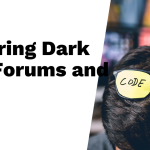The dark web is a hidden part of the internet that you can’t reach with regular browsers or search engines. To access it, people typically use special software like the Tor browser, which helps keep identities anonymous. This section is smaller than the deep web but known for both legal and illegal content. Finding sites involves using specialized search engines such as Ahmia or directories like The Hidden Wiki, though many links may be outdated or unsafe. Users also rely on crawling tools and community forums to discover new hidden pages. It’s important to stay safe by using VPNs, updated software, and avoiding suspicious downloads when exploring this concealed space online.
Table of Contents
- What Is the Dark Web and How Does It Differ from the Deep Web
- Popular Darknets and How to Access Them Safely
- How Hidden Content Is Concealed on the Dark Web
- Using Specialized Search Engines to Find Dark Web Content
- Directories, Indexes, and Community Sources for Hidden Links
- Techniques for Crawling and Scraping Dark Web Sites
- Staying Safe and Ethical While Exploring the Dark Web
- Practical Uses of Dark Web Discovery in Various Fields
- Common Challenges When Searching for Hidden Content
- Top Tools and Platforms for Effective Dark Web Discovery
- Frequently Asked Questions
What Is the Dark Web and How Does It Differ from the Deep Web

The Dark Web is a small, specialized part of the Internet that can only be accessed using special software like the Tor browser. Unlike the regular web that you browse daily, which is indexed by search engines and accessible through standard browsers, Dark Web sites hide their locations and identities through strong encryption and anonymous routing. These sites usually have addresses ending in .onion and rely on multiple layers of encryption to keep users and operators anonymous. The Dark Web is actually a subset of the much larger Deep Web, which includes all online content not indexed by search engines, such as private databases, subscription services, and internal corporate networks. While the Deep Web mostly consists of harmless, non-public information, the Dark Web focuses on anonymity and hosts a mix of both legal and illegal activities. Accessing the Dark Web itself is legal and is often used by journalists, activists, and whistleblowers to communicate securely without revealing their identities. However, many Dark Web sites are temporary, frequently changing addresses to avoid detection or shutdown. Understanding the distinction between the Deep Web and the Dark Web is important because it clarifies what types of content are hidden and the risks involved when exploring these areas.
Popular Darknets and How to Access Them Safely

The most widely used darknet is Tor, which anonymizes your online activity by routing your traffic through multiple volunteer-run relays, making it difficult to trace. To access Tor, you need the Tor Browser, a modified version of Firefox designed to connect to .onion sites and protect your identity. Another notable darknet is I2P, which operates as a peer-to-peer network optimized for hosting hidden services with internal traffic routing, providing strong anonymity for both users and service hosts. Freenet takes a different approach by creating a decentralized network focused on anonymous data storage and sharing, emphasizing resistance to censorship. Besides these, there are other networks like ZeroNet, which leverages blockchain technology for decentralized websites; Tribler, designed for anonymous torrenting; Riffle, focusing on secure messaging; and GNUnet, which supports peer-to-peer networking with privacy features. Each darknet requires specific software tailored to its protocols, so users must download and configure the appropriate clients. For better anonymity, it is recommended to use a VPN alongside Tor or other darknet clients to mask your IP address even before connecting to the network. Staying safe also means regularly updating your darknet software to patch security flaws and maintain compatibility. Disabling scripts and plugins in your browser helps reduce risks like fingerprinting or malicious attacks, which are common threats on the darknets. Since navigating these networks can be technically challenging, understanding their terminology and methods is important for effective and safe exploration. For an extra layer of security, many users run darknet clients within secure operating systems or virtual machines, isolating these activities from their main system to prevent leaks or infections.
How Hidden Content Is Concealed on the Dark Web
Dark web content stays hidden through multiple layers of technical and operational safeguards. Websites use .onion domains that can only be accessed via Tor or compatible networks, making them invisible to standard browsers and search engines. This exclusive accessibility is reinforced by layered encryption, often called onion routing, which encrypts data multiple times and routes traffic through volunteer-run relays to mask both the origin and destination. The physical locations of these hidden services remain anonymous because neither the user nor the server reveals their IP addresses during communication.
To avoid detection, many dark web sites do not appear in public listings or directories, operating instead through invite-only forums or private channels that limit exposure. URLs are also deliberately complex, often consisting of long, randomized strings rather than human-readable names, making manual discovery difficult. Some sites add extra layers of protection by requiring CAPTCHAs or login credentials to prevent automated crawling or scraping, reducing the risk of being indexed or attacked.
Content is further protected by encryption at rest, meaning even if data is intercepted or the server is compromised, unauthorized access remains challenging. Frequent changes in URLs and server locations add a moving target element, making persistent tracking or mapping of sites difficult. Technical measures such as disabling scripts and limiting metadata help reduce fingerprinting risks, ensuring users and hosts remain anonymous. Together, these methods form a robust system designed to conceal content and identities, preserving the dark web’s core principle of privacy and secrecy.
Using Specialized Search Engines to Find Dark Web Content
Dark Web search engines are specifically designed to index .onion sites by crawling available hidden services within the limits of what they can access. Unlike traditional search engines, these tools face unique challenges such as site volatility, limited crawling permissions, and the often unstructured nature of content. DuckDuckGo provides a Tor-accessible version that respects user privacy and avoids tracking, but it only indexes privacy-focused sites, which means its coverage can be limited. Ahmia is another popular engine that indexes Tor hidden services while filtering out many illegal or malicious sites, offering cleaner and safer search results for casual users. NotEvil, which emerged after TorSearch was discontinued, continues to offer a searchable index of .onion sites, though like others, it cannot guarantee full coverage due to the dark web’s shifting landscape. Yippy acts as a metasearch engine by aggregating results from multiple sources, including dark web content, thus broadening the search scope. Other engines such as Torch and Candle have different indexing methods and levels of coverage, each with their own strengths and weaknesses. For those interested in darknet marketplaces specifically, engines like Kilos and Grams specialize in tracking product listings and vendor information, but users should exercise extra caution since marketplace data can be risky or outdated. Given the high risk of deceptive or malicious results, it’s wise to use multiple search engines and cross-reference directories to improve the chances of finding relevant and legitimate hidden content on the dark web.
Directories, Indexes, and Community Sources for Hidden Links
When exploring the dark web, directories and community sources play a crucial role in finding hidden .onion links. The Hidden Wiki is one of the most well-known directories, offering categorized lists of onion sites, but it often contains outdated or malicious links, so users must approach it cautiously. To get more reliable and current links, many rely on community-maintained lists and forums where users actively share updates about site availability. These platforms are invaluable because dark web URLs frequently change or disappear, requiring constant verification. Another notable directory is the WWW Virtual Library, an older system that categorizes deep web resources, including hidden services, though it is less frequently updated today. Beyond static directories, darknet forums and IRC channels serve as dynamic hubs where members share fresh or working onion addresses, often verifying links through word of mouth or trusted reputation. Some directories are curated with moderation to exclude illegal or harmful content, but many have little to no oversight, so users must be vigilant. Social media groups focused on dark web research sometimes provide additional avenues for discovering links, often accompanied by user ratings and comments that help assess reliability and warn about potential risks. Combining these indexes with dark web search engines can deepen exploration, but the ephemeral nature of many sites means links need regular checking to avoid dead ends or scams. Overall, navigating directories and community sources requires a mix of caution, trust in reputable users, and ongoing effort to verify the authenticity and safety of hidden links.
Techniques for Crawling and Scraping Dark Web Sites

Crawling and scraping the dark web presents unique challenges compared to the surface web. Automated crawlers can access Tor hidden services by routing requests through Tor clients configured for this purpose, but they face restrictions like site volatility, captchas, and strict rate limits designed to prevent abuse. Dark web sites often change URLs frequently and remain temporarily available, which reduces crawler effectiveness and makes data freshness a constant concern. To handle these issues, researchers build custom tools that maintain anonymity, recover from network interruptions, and adapt to access controls. Scrapers focus on extracting data such as marketplace listings, forum posts, or contact information to support cybersecurity monitoring, law enforcement investigations, or academic research. Ethical considerations are critical: overloading dark web servers can disrupt services, so crawlers must respect access limits and site terms. Legal boundaries also limit scraping, especially around illegal content or personal user data. Combining automated crawling with manual verification helps improve data quality and relevance. Some crawlers integrate with dark web search engines or directories to expand coverage, providing a broader snapshot of hidden content. Despite technical hurdles, these techniques remain essential for discovering and analyzing dark web resources without causing undue harm or legal risk.
Staying Safe and Ethical While Exploring the Dark Web
Accessing the dark web requires careful attention to safety and ethics. Always use the Tor Browser or a similar specialized browser designed for darknet access, as these include built-in privacy features that help protect your identity. It’s wise to combine Tor with a reliable VPN to add an extra layer of IP protection and prevent your internet service provider from monitoring your activity. Make sure your operating system and all software, especially browsers, are fully updated to patch any known vulnerabilities. Avoid downloading files or clicking on links from untrusted sources, as these can contain malware that compromises your system. Using two-factor authentication on any accounts accessible through the dark web adds an important security step. To keep your main system safe, consider browsing in a sandboxed environment or a virtual machine, isolating your dark web activity from your everyday computer. Disabling scripts and plugins in the Tor Browser can reduce the risk of tracking or exploitation. Ethically, steer clear of illegal marketplaces and content to avoid legal trouble and support responsible use of the dark web. Be cautious when sharing personal information or credentials, since anonymity on the dark web does not guarantee safety. For those conducting research or investigations, specialized monitoring tools can limit exposure and improve data collection without unnecessary risk.
- Use the Tor Browser or equivalent specialized browsers designed for darknet access with built-in privacy features.
- Employ a reliable VPN alongside Tor for an extra layer of IP protection and to prevent ISP monitoring.
- Keep all software, including the operating system and browsers, updated to patch known vulnerabilities.
- Avoid downloading files or opening links from untrusted sources to prevent malware infections.
- Use two-factor authentication on any accounts accessible via the Dark Web to enhance security.
- Never engage with illegal marketplaces or content to maintain ethical and legal compliance.
- Consider using sandboxed or virtual machine environments to isolate Dark Web browsing from the main system.
- Disable scripts and plugins in the Tor Browser to reduce risks of tracking or exploitation.
- Be cautious about sharing personal information or credentials on any Dark Web platform.
- Use specialized monitoring tools if conducting investigations to limit exposure and improve data collection.
Practical Uses of Dark Web Discovery in Various Fields
Dark web discovery plays a vital role across multiple sectors by providing access to information and monitoring opportunities that are otherwise hard to obtain. In cybersecurity, professionals track the dark web to find stolen credentials, ransomware kits, and communications among threat actors. This proactive approach helps organizations prepare for and prevent attacks. Journalists and activists use the dark web as a secure platform for anonymous communication and whistleblowing, protecting sources in sensitive or oppressive environments. Researchers benefit from shadow libraries like Sci-Hub and Z-Library, which offer free access to scientific papers and books, helping overcome paywall restrictions. Law enforcement agencies rely on dark web discovery to monitor illegal trade, identify criminal networks, and gather intelligence that supports investigations. Businesses keep an eye on leaked data and insider threats exposed on hidden services to safeguard corporate assets. Health organizations explore dark web forums and marketplaces to detect counterfeit drugs and gather information on medical devices that might pose risks. Financial institutions track fraud schemes and illicit transactions occurring on dark web marketplaces to protect customers and comply with regulations. Human rights groups utilize dark web tools to communicate safely in regions with heavy censorship, ensuring their messages reach the outside world. Cyber threat intelligence teams analyze chatter on the dark web to anticipate attacks, allowing for timely countermeasures. Educational institutions study the dark web to understand digital privacy, cybersecurity threats, and social behaviors linked to hidden online communities. Together, these practical uses show how dark web discovery is not just about uncovering illegal content but also about leveraging hidden data for security, research, and social good.
Common Challenges When Searching for Hidden Content
Finding hidden content on the dark web comes with several challenges that make persistent discovery difficult. Many hidden services frequently change URLs or go offline without notice, so links that worked yesterday might be dead today. There is no centralized index or directory for the dark web, which means search engines often have incomplete or outdated listings. This volatility complicates content aggregation and forces users to rely on multiple sources or community forums for updated links. Additionally, scams, phishing sites, and malicious content are widespread, posing significant risks to users who may accidentally download malware or fall victim to fraud. Legal and ethical risks are also a concern, since interacting with certain content can have serious consequences depending on local laws and regulations. The technical complexity of accessing the dark web requires knowledge of specific protocols, software like Tor, and security best practices to maintain anonymity and safety. Automated crawling and indexing face limitations due to slow network speeds, access restrictions, and many sites using CAPTCHAs or authentication to block bots. Navigating the dark web often means dealing with unstructured or poorly maintained sites, which can lead to dead ends or misinformation. Balancing the need for effective exploration with the imperative of staying anonymous and secure demands ongoing vigilance and learning from users.
Top Tools and Platforms for Effective Dark Web Discovery
Accessing the dark web starts with the Tor Browser, which is essential for reaching .onion sites while providing built-in privacy features and routing your traffic through multiple relays to keep your identity hidden. For searching hidden services, DuckDuckGo offers a Tor hidden service that respects user privacy by not tracking searches, making it a reliable option for initial exploration. Ahmia improves search quality by indexing Tor hidden services and filtering out illegal or spam content, helping users find legitimate sites more efficiently. Another useful search engine is NotEvil, which focuses on usability and serves as a practical alternative for discovering .onion pages. The Hidden Wiki acts as a popular entry point by offering a directory of many well-known and niche hidden services, though users should approach it cautiously due to occasional outdated or malicious links. For those interested in decentralized and anonymous data sharing, Freenet provides a peer-to-peer network that allows access to hidden content beyond traditional Tor sites, though it tends to be slower. Adding a VPN alongside Tor is highly recommended as it masks your IP address further, enhancing security and anonymity during your dark web activities. On the content side, platforms like Sci-Hub and Z-Library are widely used to access large collections of academic papers and general literature, often unavailable through conventional means. For researchers and cybersecurity professionals, specialized crawling and scraping tools help collect data from dark web sites, although the volatile nature of these sites limits extensive indexing. Finally, community forums and darknet marketplaces, when accessed carefully, offer real-time information, fresh links, and updates on the latest hidden services, playing a key role in ongoing discovery and navigation of the dark web.
| Tool/Platform | Purpose | Notes |
|---|---|---|
| Tor Browser | Access to .onion sites | Essential for dark web access |
| DuckDuckGo | Privacy-centric search engine | Has Tor hidden service |
| Ahmia | Search engine indexing Tor hidden services | Filters illegal content |
| NotEvil | Dark web search engine | Successor to TorSearch |
| The Hidden Wiki | Directory of .onion links | Useful but must be used cautiously |
| Freenet | Decentralized peer-to-peer network | Slower, anonymous data sharing |
| VPNs | Anonymity and IP masking | Recommended to use alongside Tor |
| Sci-Hub, Z-Library | Access to academic and general books | Popular shadow libraries on dark web |
Frequently Asked Questions
1. What tools do I need to safely explore the dark web?
To safely explore the dark web, you typically need a specialized browser like Tor, which anonymizes your activity. It’s also wise to use a VPN for extra privacy and to keep your software updated to protect against security risks.
2. How do I search for hidden websites that aren’t indexed by regular search engines?
Hidden websites on the dark web often use .onion addresses and aren’t found through regular search engines. You can use dark web-specific directories and search engines like Ahmia or DuckDuckGo’s onion service to discover these sites.
3. Is it possible to verify if information found on the dark web is trustworthy?
Verifying information on the dark web can be challenging due to anonymity and lack of oversight. Cross-check facts with multiple sources when possible and be cautious of rumors or unverifiable claims.
4. What are the risks of browsing hidden content on the dark web?
Browsing the dark web carries risks such as exposure to illegal content, scams, malware, and potential tracking if proper precautions aren’t taken. It’s important to maintain strong security measures and avoid interacting with suspicious links or downloads.
5. Can I access the dark web on my mobile device safely?
Yes, you can access the dark web on mobile devices using apps like the Onion Browser for iOS or Tor-enabled browsers for Android. However, mobile devices may have different security vulnerabilities, so it’s crucial to follow safety guidelines and avoid downloading unknown files.
TL;DR The dark web is a hidden part of the internet, accessible only through special tools like the Tor browser, and differs from the broader deep web by its focus on anonymity and often illicit content. You can explore it safely using darknets such as Tor, I2P, and Freenet, along with specialized search engines like Ahmia and directories like The Hidden Wiki. Discovering hidden content involves crawling, scraping, and engaging with community forums, but requires careful adherence to legal and ethical guidelines. While challenges like fleeting URLs and scams exist, dark web discovery has practical uses in cybersecurity, journalism, research, and law enforcement. Using the right tools, staying updated, and prioritizing safety can make navigating this hidden online space more effective and responsible.





